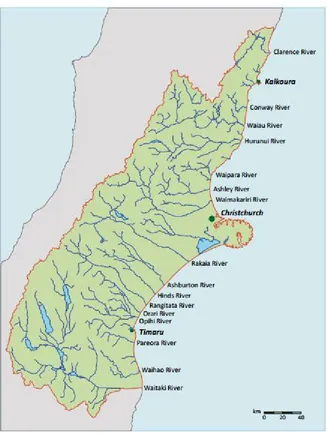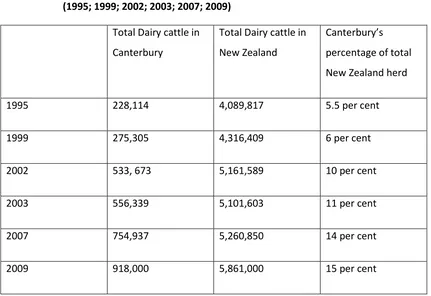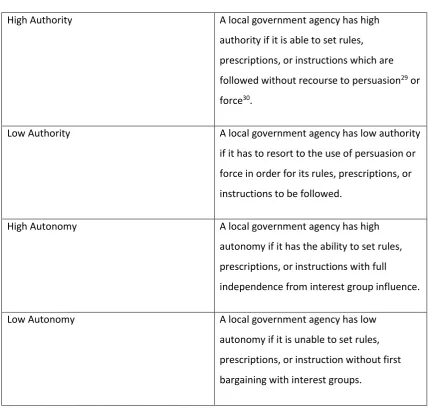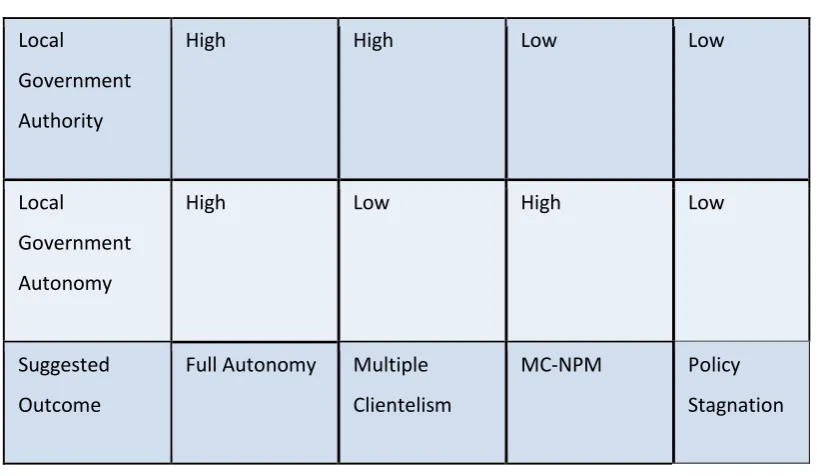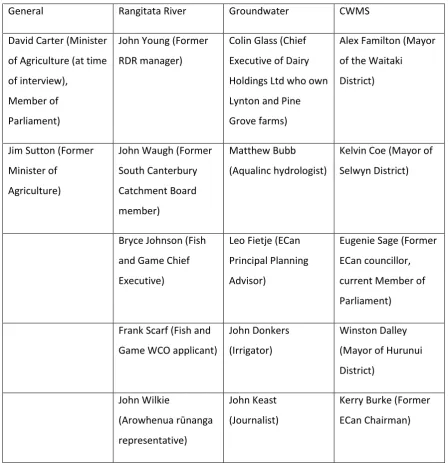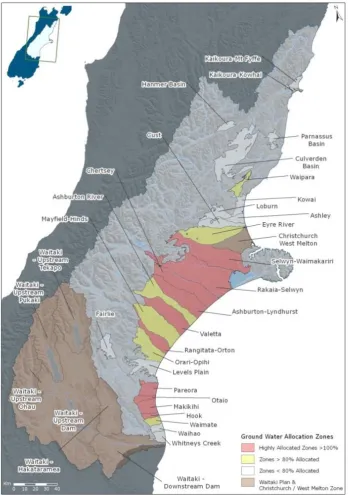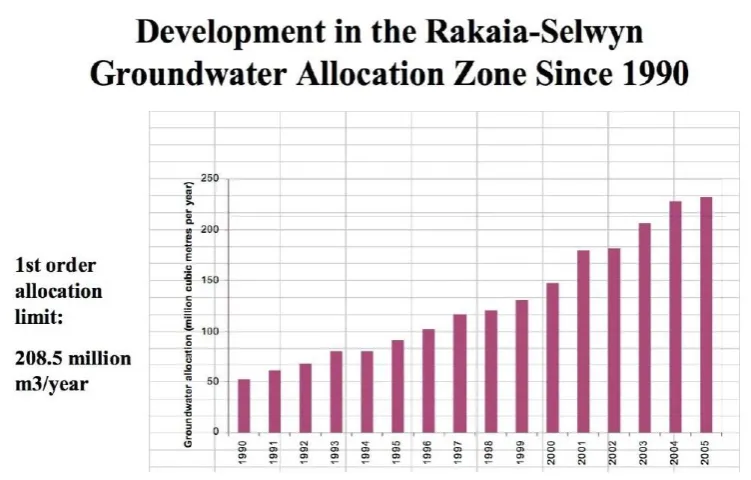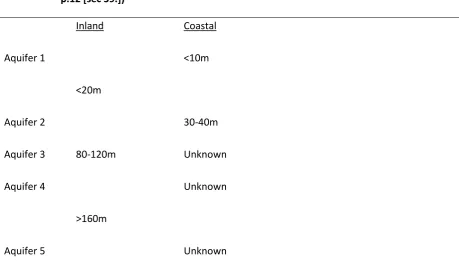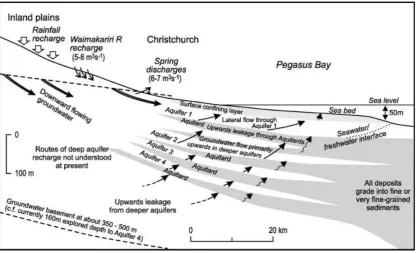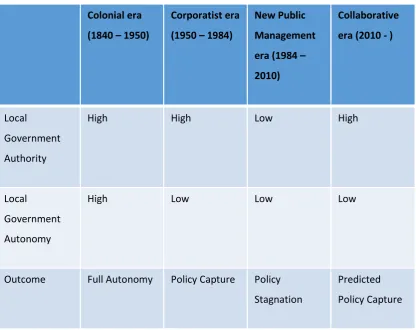Lincoln University Digital Thesis
Copyright
Statement
The
digital
copy
of
this
thesis
is
protected
by
the
Copyright
Act
1994
(New
Zealand).
This
thesis
may
be
consulted
by
you,
provided
you
comply
with
the
provisions
of
the
Act
and
the
following
conditions
of
use:
you
will
use
the
copy
only
for
the
purposes
of
research
or
private
study
you
will
recognise
the
author's
right
to
be
identified
as
the
author
of
the
thesis
and
due
acknowledgement
will
be
made
to
the
author
where
appropriate
you
will
obtain
the
author's
permission
before
publishing
any
material
from
the
thesis.
Local government authority and autonomy in Canterbury’s
freshwater politics between 1989 and 2010.
A thesis
submitted in partial fulfilment
of the requirements for the Degree of
Doctor of Philosophy
at
Lincoln University
by
Nicholas Allan Kirk
Lincoln University
Abstract of a thesis submitted in partial fulfilment of the
requirements for the Degree of Doctor of Philosophy.
Abstract
Local government authority and autonomy in Canterbury’s freshwater politics
between 1989 and 2010.
by
Nicholas Allan Kirk
This thesis proposes a hybrid theory, informed by multiple clientelism and New Public Management,
to examine local government authority and autonomy under interest group influence in a modern
New Zealand context. Multiple clientelism theory suggests that a local government agency can
establish authority and autonomy over natural resource use through selective and sequential
patronage with competing interest groups. Multiple clientelism was devised during an examination
of American federal lands politics in the 1970s, an era of big government. By contrast, this thesis
examines multiple clientelism in the context of New Zealand’s New Public Management reforms
during which central government retreated somewhat from natural resource management. During
New Zealand’s New Public Management reform era, natural resource management responsibilities
were tranfered from a collection of central and local government agencies to regional councils. Also
during this period, the Resource Management Act was introduced which required regional councils
to manage and regulate the environmental effects of resource use.
The predictions of the hybrid theory are examined through analysis of the Canterbury Regional
Council’s freshwater management between 1989 and 2010. The Council was created in 1989 as an
amalgamation of various government agencies. The Canterbury Regional Council navigated between
pro-development and pro-conservation interest groups who desired contrasting policy over
freshwater use. Three case studies were investigated using qualitative methods to examine how the
Council pursued authority and autonomy over Canterbury’s freshwater management.
In the three case studies, the Canterbury Regional Council struggled in its pursuit of authority and
autonomy despite attempting selective and sequential patronage as multiple clientelism predicted.
In response, the Council initiated collaborative governance arrangements to regain some authority
captured by powerful interest groups. New Public Management reforms for freshwater policy were
initiated, in part, to limit the potential capture of policy by interest groups. As a result, I propose the
counterintuitive conclusion of a cycle between policy capture and policy stagnation in Canterbury’s
freshwater politics.
Keywords: multiple clientelism; New Public Management; collaborative governance; freshwater
management; Canterbury Regional Council; Environment Canterbury; Resource Management Act;
Preface and Acknowledgements
My interest in Canterbury’s freshwater management began after the removal of regional councillors
through the Environment Canterbury (Temporary Commissioners and Improved Water Management)
Act in April 2010. At the time, I was working as a research assistant for Professor Ali Memon who
gave me some insight into the controversies that had plagued the Canterbury Regional Council. The
Canterbury Regional Council had struggled to issue consents for freshwater use within statutory
timeframes which angered its farming constituents. The Regional Council had also struggled to create
a regional plan which angered environmentalist constituents who wanted limits to be established to
freshwater abstraction in the region.
I mentioned to Professor Memon that we should research why the Canterbury Regional Council had
struggled to adequately manage freshwater to analyse if the central government intervention was
justified. Professor Memon agreed and encouraged me to apply for a Lincoln University PhD
scholarship to study the topic. Unfortunately, I submitted my PhD scholarship application to a
secretary who was about to go on maternity leave. My scholarship application was subsequently left
in a to-do-bin and I learnt a few weeks later that my application had not been processed on time.
Thankfully, Professor Memon appealed to the PhD scholarship committee that I had not been given a
fair hearing. He argued that they ought to reconsider my application, and after this lobbying I was
lucky enough to receive a scholarship.
This thesis is a continuation of the research I started with Professor Memon in 2008. During this
period, I was able to contribute to several co-authored papers which were published in local and
international journals. I am indebted to Professor Memon for his tutelage as well as his efforts in
helping me obtain a PhD scholarship. I dedicate this thesis to him.
I would also like to acknowledge my supervision team for this thesis which consisted of Associate
Professor Ton Bührs, Dr Ann Brower and Dr Ronlyn Duncan. Professor Buhrs helped me a lot after the
retirement of Professor Memon and shepherded this thesis during its early stages. I would like to
acknowledge the substantial efforts of Dr Ann Brower, who after Ton’s retirement helped me shape
the thesis. Ann encouraged me to seek greater precision with my writing and my research. Ann spent
many hours reading drafts of this thesis and taught me how to craft these early drafts into a clear
and concise manuscript. I would also like to acknowledge the efforts of Dr Ronlyn Duncan. Ronlyn has
always encouraged me to explore alternative theoretical avenues and was also of great assistance
when discussing the content of my case studies.
During my time at Lincoln University I had the pleasure of working alongside a variety of academic
Professor Ken Hughey, Dr Mike O’Connell, Professor Simon Swaffield and Dr Suzanne Vallance for
employing me in a variety of research and teaching roles. I would like to thank Dr Hamish Rennie and
Dr Hugh Logan for their advice and assistance. I would also like to thank Tracey Shields, Alyson
Gardner, Douglas Broughton, and Michelle Collings. Everyone listed exemplifies the friendly and
helpful culture of staff at Lincoln.
I would like to thank all the research interviewees for their participation in this project. I would also
like to thank the Rangitata Diversion Race for allowing me to research documents at their
headquarters in Ashburton. I also would like to acknowledge the assistance of Malcolm Douglass who
sent me several documents after an interview request.
I would finally like to thank my family for their support during this period. I would like to
acknowledge my parents, Ann and Ray Kirk, for their tireless support of my research over the last ten
years. They have gone above and beyond to help me complete this project and it would not have
been possible without their love and support. I would also like to thank my brothers Andrew and
Table of Contents
Abstract ... ii
Preface and Acknowledgements ... iv
Table of Contents ... vi
List of Tables ... ix
List of Figures ... ix
1. Chapter One Introduction ... 1
1.1 Introduction ... 1
1.2 Multiple clientelism ... 5
1.3 New Public Management ... 6
1.4 The Resource Management Act and sustainable development ... 7
1.5 Research Question ... 8
1.6 Organisation of the thesis ... 8
2. Chapter Two Multiple clientelism and the corporatist era of interest group politics in New Zealand ... 10
2.1. Introduction ... 10
2.2. Roots of multiple clientelism ... 11
2.3. Multiple clientelism ... 12
2.4. The emergence of environmental interest groups – the Lake Manapouri dam protests ... 16
2.4.1. The corporatist era of interest group politics in New Zealand – 1949 to 1984 ... 18
2.4.2. Strengthening corporatism – the Water and Soil Conservation Act 1967 ... 18
2.4.3. Environmental concessions – the 1981 Wild and Scenic Rivers Amendment ... 21
2.5. Conclusion ... 22
3. Chapter Three New Public Management in New Zealand ... 24
3.1. Introduction ... 24
3.2. New Public Management – a new reform agenda ... 24
3.3. New Zealand’s New Public Management reforms ... 26
3.3.1. Privatization of irrigation schemes ... 29
3.3.2. The Resource Management Act ... 30
3.3.3. The creation of regional councils in New Zealand ... 31
3.3.4. The removal of subsidies ... 32
3.4. New Public Management – the second interest group era ... 33
3.5. Collaboration – an emergent third interest group era ... 34
3.6. MC-NPM hybrid theory ... 36
3.7. MC-NPM hybrid theory and competing theories of policy ... 38
3.8. Conclusion ... 40
4. Chapter Four Methods ... 42
4.1. Introduction ... 42
4.2. Case study method ... 42
4.3. Interview methods ... 44
4.4. Secondary material ... 47
4.4.1. Documentary evidence ... 47
4.4.2. Archival evidence ... 47
4.5. Data analysis ... 47
4.5.1. Interview data ... 48
4.5.2. Secondary data... 48
4.6. Selected case studies ... 48
4.7. Conclusion ... 49
5. Chapter Five Case study 1 – the Rangitata River Water Conservation Order ... 50
5.1. Introduction ... 50
5.2. Rangitata River – a brief history... 50
5.3. What is a Water Conservation Order? ... 51
5.4. The Rangitata River debate ... 52
5.4.1. ECan’s justification for a management plan rather than a WCO ... 54
5.5. The Water Conservation Order Tribunal hearing and Environment Court appeal ... 56
5.5.1. WCO tribunal hearing ... 56
5.5.2. Environment Court appeal ... 58
5.5.3. Decision and reaction ... 58
5.6. Conclusion ... 59
6. Chapter Six Case Study 2 – Groundwater zoning in Canterbury ... 61
6.1. Introduction ... 61
6.2. Groundwater use in Canterbury – a history ... 61
6.3. The Environment Court, resource consents, and regional plans ... 62
6.4. Groundwater Zoning Case Study – creation of groundwater zones ... 64
6.5. Challenges to the groundwater zones ... 68
6.5.1. Explaining the success of Lynton and Pine Grove dairies at the Environment Court ... 72
6.5.2. The Restorative Programme for Lowland Streams ... 72
6.6. RMA processes without a plan – management of cumulative effects ... 76
6.7. Conclusion ... 77
7. Chapter Seven Case Study 3 – the Canterbury Water Management Strategy ... 79
7.1. Introduction ... 79
7.2. Problems with ECan’s management and governance ... 79
7.3. The Canterbury Strategic Water Study ... 80
7.4. ECan’s Natural Resources Regional Plan ... 82
7.5. The Canterbury Water Management Strategy ... 83
7.5.1. Creation of the CWMS ... 84
7.5.2. Publication of the CWMS ... 85
7.5.3. The CWMS and targets for Canterbury’s freshwater use ... 88
7.5.4. Water storage, land use, water quality and environmental protection ... 88
7.6. The Creech Report and the ECan Act ... 89
7.7. Conclusion ... 91
8.1. Introduction ... 93
8.2. How did ECan pursue authority and autonomy in the three case studies? ... 94
8.2.1. Rangitata River case study ... 94
8.2.2. Groundwater case study ... 95
8.2.3. Canterbury Water Management Strategy case study ... 97
8.3. MC-NPM hybrid theory ... 98
8.4. Issues with collaborative governance ... 100
8.4.1. Collaboration and power ... 101
8.4.2. Collaborations normative argument ... 102
8.5. Authority, Autonomy, and Interest Group influence ... 104
8.5.1. Authority, Autonomy, and Interest Groups in the Corporatist era ... 104
8.5.2. Authority, Autonomy, and Interest Groups in the New Public Management era ... 105
8.5.3. Authority, Autonomy and Interest Groups in the Collaboration era ... 105
8.6. Cycle of interest group politics in Canterbury ... 106
8.7. Conclusion ... 108
9. Chapter Nine Conclusion ...110
9.1. Introduction ... 110
9.2. Contribution to knowledge ... 110
9.3. Contribution to theory ... 111
9.4. Questions for further research ... 112
9.5. Implications for policy ... 112
9.6. Conclusion ... 113
Appendix One The pre-colonial management of freshwater in Canterbury ...114
Appendix Two The drainage of Te Waihora/Lake Ellesmere ...115
Appendix Three The political power of farmers in Canterbury between 1850 – 1960 ...117
Appendix Four Canterbury Strategic Water Study multi-stakeholder steering committee (Whitehouse et al., 2008, p.60). . ...120
Appendix Five Canterbury Water Management Strategy steering group members (Mayoral Forum, 2009, p.66). ...121
Appendix Six List of government publications cited in the thesis. ...122
List of Tables
Table 1 Dairy Cattle in Canterbury – 1995 to 2009 –Statistics New Zealand Agricultural Census
(1995; 1999; 2002; 2003; 2007; 2009). ... 11
Table 2 Criteria for high and low authority and autonomy... 36
Table 3 Local government authority and autonomy in natural resource management. ... 38
Table 4 List of research interviewees. ... 45
Table 5 Surface water abstraction from the Rangitata River (circa May 2001) (Rangitata River Water Conservation Order tribunal, 2002, p.79). ... 55
Table 6 Proposed surface water abstraction from the Rangitata River into the Timaru District (Jenkins, 2013; NZRCA, 2000). ... 55
Table 7 Aquifer depths in the Rakaia-Selwyn groundwater zone (Lynton Dairy Env Court, 2005, p.12 [sec 39.]). ... 69
Table 8 Water inputs to the Rakaia – Selwyn Groundwater Zone (White, 2009, p.67, as reported by Anthony Davoren during the Rakaia-Selwyn hearings). ... 75
Table 9 Proposed cycle of policy capture and policy stagnation in Canterbury’s freshwater politics. ... 107
List of Figures
Figure 1 Canterbury’s rivers –MfE (2015). ... 2Figure 2 A general group influence model (Culhane, 1981, p.291). ... 13
Figure 3 The public lands group influence model (Culhane, 1981, p.297). ... 14
Figure 4 Groundwater allocation zones in Canterbury (Source Environment Canterbury). ... 66
Figure 5 Development in the Rakaia-Selwyn groundwater allocation zone since 1990 (Jenkins, 2007, p.5). ... 67
1.
Chapter One
Introduction
1.1
Introduction
The Canterbury region of New Zealand’s South Island contains 23 per cent of the nation’s agricultural
land (Creech, Jenkins, Hill & Low, 2010, p.5). Following the European colonisation of New Zealand,
this land has been integral to New Zealand’s export-based economy. Early colonists noted that access
to freshwater would be necessary to farm Canterbury’s land (Cameron, 2009). In response, colonists
in the 19th century built water races to quench the thirst of imported stock animals (Scotter, 1965b;
Pawson, 2001). In the 20th century New Zealand’s government used public money to build irrigation
schemes in Canterbury (Roche, 1994). However, by 1984 New Zealand’s Treasury argued that the
benefits of public investment in irrigation infrastructure had been “captured entirely by private
landowners within the schemes” (Treasury, 1984, p.46). New Zealand’s government responded by
selling irrigation schemes to users in the hope that freshwater policy would not be captured in the
future (Farley, 1994). During the 1990s and 2000s, farmers in Canterbury requested access to more
irrigable freshwater to farm their land profitably, while environmental interest groups lobbied for the
conservation of Canterbury’s freshwater resources. A new local government agency – the Canterbury
Regional Council (abbreviated throughout to Environment Canterbury or ECan) - became responsible
for managing and regulating the competing demands for freshwater use and conservation from
1989. This thesis investigates ECan’s vexed management of freshwater from its amalgamation in
1989 until its restructuring in 2010. This investigation produced some unexpected results. The
research findings suggest that Canterbury’s freshwater policy could become captured by interest
groups in the future despite the efforts of reformers in the 1980s to eliminate capture of freshwater
policy. As a result of this counterintuitive conclusion, I propose a cycle between policy capture and
policy stagnation in Canterbury’s freshwater politics.
The Canterbury region in New Zealand’s South Island is the setting for this research. 58 per cent of
freshwater allocated for consumptive purposes in New Zealand is abstracted from Canterbury’s
streams, rivers, lakes, and underground aquifers (Mayoral Forum 2009: 23). As seen in Figure 1,
Canterbury’s rivers either originate from the Southern Alps – such as the braided Rangitata, Rakaia,
and Waimakariri Rivers – or from the eastern foothills – such as the Orari, Hinds, Selwyn, and Ashley
Rivers (Hayward & Ackley, 1983, p.43; Winterbourn, 2008). Rivers are fed by groundwater, rain, and
snow. Rainfall on the eastern foothills infiltrates through the soil to recharge underground aquifers
Canterbury’s urban centre Christchurch pumps all of its drinking water from untreated underground
aquifers (Hoben, 1914; Chilton, 1924; Hercus, 1948; Dicker, 1993). Canterbury receives less rainfall
than most areas of New Zealand, however, the Southern Alps on Canterbury’s western boundary
ensures rivers and aquifers carry ample freshwater downhill towards the Pacific Ocean.
Figure 1 Canterbury’s rivers –MfE (2015).
These diverse sources of freshwater are managed and regulated by the Canterbury Regional Council.
New Zealand is a constitutional monarchy with a unicameral Parliamentary system (Jackson, 2003),
and local government agencies – such as ECan – are given legal rights and responsibilities by
Parliament. For example, local governments in New Zealand can own property, employ staff, and
enter into contracts (Bush, 2003, p.161). Nonetheless, local governments in New Zealand do not have
legislative sovereignty. Only New Zealand’s Parliament has the sovereignty to enact law, and
structures, authorities, and responsibilities of New Zealand’s local governments are established by
laws enacted by Parliament.
New Zealand’s local government agencies struggled to exercise autonomy during the 1960s and
1970s (Bush, 1980). These agencies were confronted by new demands as well as financial and
functional inadequacies (Bush 1980, pp. 44-5). Regional united council responsibilities were poorly
defined and overlapped with older road boards, country towns, and county boroughs. Graham Bush
(1980, p.45) argued that “it was not a stable, placid era where each component had its station and
was guaranteed immunity from interference”. Because New Zealand does not have a federal system
of government, New Zealand’s local governments will never gain full autonomy from Parliament.
Given this context, authority is defined in this research as a local government agency having “the
right or capacity, or both, to have proposals or prescriptions or instructions accepted without
recourse to persuasion…or force“(Reeve, 2009)1. This follows contemporary political philosophers
who argue that for a state to have authority its rules and commands must be followed by its citizens
(Christiano, 2013). A citizen obeys state rules and commands because state officials exercise
normative (morally justified) authority rather than non-normative (de facto) authority (ibid).
There are several concepts of legitimate state authority. There is legitimate political authority as
justified coercion, or legitimate political authority as the ability to impose duties on citizens
(Christiano, 2013). However, I have chosen to use legitimate political authority as the right to rule.
This means that citizens do not have a duty to comply with rules, however, an authority might offer a
justification for its right to rule (Ladenson 1980). Therefore, the state has permission to issue
commands as well as to coerce citizens into following them, but citizens can argue against these rules
or choose to not comply and face the consequences.
Autonomy is defined in this thesis as a local government agency having independence from
non-governmental groups (interest groups, business groups, etc.) to set proposals, prescriptions, and/or
instructions. Michael Mann (1984) has argued that states have autonomous power. Mann’s
argument is that the state is autonomous of civil society actors such as interest groups and business
associations. Because civil society actors’ desire that some activities – for example, water use and
allocation – are regulated by a central agency, they willingly cede resources to the state. A state is
unique because, unlike the civil society actors, it’s centralized and territorially bound. Thus, the state
1 In Andrew Reeve’s original definition of state authority, he argues that authority is the capacity to “have
can be influenced by civil society actors – and frequently is – but it occupies a space, and obtains a
power which is unique from civil society. Mann (1984) concludes that the power and autonomy of
states has varied greatly throughout history.
The context in which New Zealand’s local governments exercise authority and autonomy changed in
the 1980s. New Zealand’s Labour Party campaigned during the 1987 national election to reform local
government functions and boundaries (Bush, 1990, p. 326). Labour was successfully elected and
passed the Local Government Amendment Act (no. 2) in 1989. This Amendment merged an
estimated 850 single and multi-purpose local government agencies into 86 multi-purpose agencies
(Cheyne, 2002, p. 127). The Local Government Amendment Act established directly elected regional
councils. The Statement on Reform of Local Government argued that “regional councils will have a
primary role in resource management” and that the boundaries of regional councils should conform
to one or more freshwater catchments (Bassett, 1988, p. 5). The Statement also proposed a
“separation of regulatory and service delivery responsibilities” (Bassett, 1988, p. 8). Central
government2 envisioned that new regional councils would exercise regulatory responsibilities
whereas territorial authorities3 would exercise service delivery responsibilities.
Two united councils – Canterbury and Aorangi – amalgamated to create the Canterbury Regional
Council on 9th June 1989 (Douglass, 2004a, p. 3). United councils exercised limited responsibilities
and often had no independent source of income (Bush, 1980, pp. 69-70). United councillors were
appointed by the territorial authorities within its boundaries (ibid). The election of regional
councillors, and the expansion of the council’s mandate to include regulation of natural resource use,
was a significant restructuring of New Zealand’s local government.
The Resource Management Act (RMA) was enacted by Parliament during the first term of the
Canterbury Regional Council on the 22nd July 1991. The RMA revolutionised environmental
management in New Zealand by integrating the management of land, air, coastal, and freshwater
resources in one piece of legislation for the first time. The purpose of the RMA was to “promote the
sustainable management” of natural and physical resources (RMA, 1991, p. 68 [sec.5 (1)]). Regional
councils were now responsible for regulating the use of natural and physical resources to ensure its
sustainable management.
2 Central government refers to the executive branch of New Zealand’s unicameral Parliament. Central
government propose the majority of laws that are passed by Parliament. New Zealand introduced a Mixed Member Proportional (MMP) electoral system in 1996 which means that it is unlikely that the executive will be made up of members of one political party. However, prior to MMP this occurred frequently.
3 Territorial authorities are the second tier of local government in New Zealand. Territorial authorities are
Prior to the RMA, planning legislation sanctioned activities in particular permitted areas (Peart, 2007,
p. 15). By contrast, the RMA promoted sustainable management through regulating the effects of
activities (ibid). Under the RMA, entrepreneurs determine the location of resource use while regional
councils regulate and manage the effects of resource use (Berke, Crawford, Dixon, & Ericksen, 1999,
p. 450).
Local government and resource management reform were part of a broader project of state sector
reform (Boston & Dalziel, 1992; Boston, Martin, Pallot, & Walsh,1996). New Zealand faced a fiscal
debt crisis following the election of the fourth Labour government in 1984 (James, 1986, p. 171). This
crisis provided the impetus for reform. Labour’s reforms substituted Keynesian economic policies,
which had prevailed in New Zealand since 1935, with a more market-based laissez faire approach
(James, 1986; Roper, 1993; Kelsey, 1997). These reforms reduced central government control over
New Zealand’s economy.
By 1991 the new Canterbury Regional Council was in a state of flux. The elected regional councillors
were now responsible for the regulation of natural resources in New Zealand’s largest regional
council. I examine how the new regional council - created through an amalgamation of local
government agencies that struggled to make autonomous decisions - pursued authority and
autonomy given state sector reforms. I use the lens of multiple clientelism to examine how ECan
pursued authority and autonomy over freshwater management in Canterbury between 1989 and
2010.
1.2
Multiple clientelism
Multiple clientelism is a theory of natural resource management which analyses governmental
authority and autonomy under interest group influence (Culhane, 1981). Multiple clientelism argues
that governmental agencies establish relationships of patronage with interest groups to gain
authority and autonomy over contentious natural resource management issues (Culhane, 1981, p.
334). Multiple clientelism predicts that a governmental agency will be influenced by multiple
customers. In Paul Culhane’s research, these customers included development and
pro-conservation interest groups (Culhane, 1981, pp. 294-5). Culhane concluded that an agency will be
influenced by multiple customers, and in response, chooses to establish relationships of patronage
with both pro-development and pro-conservation interest groups at different times (Culhane, 1981;
Mohai, 1987). Policy capture4 will be avoided because the agency is “variably captured” by different
4 Policy capture is also referred to as “agency capture” or “regulatory capture”. I have chosen to use the term
interest groups (Culhane, 1981, p. 334). The agency will reach decisions that reflect the diversity of
its interest group clientele.
In sum, multiple clientelism offers an explanation of how ECan can establish authority and autonomy
when influenced by multiple competing interest groups. ECan, by establishing relationships of
selective and sequential patronage with interest groups, can reach diverse decisions over freshwater
policy. ECan’s authority and autonomy will be strengthened through gaining the support of multiple
interest groups. Multiple clientelism is an influential theory of natural resource management,
however, it was devised in 1981 during the era of big government (Walker & Vatter, 1997, pp.
109-110). By contrast, ECan was amalgamated during an era typified by the retreat of the regulatory state
(Gunningham, 2009, p. 158). The New Public Management reforms, introduced to New Zealand
between 1984 and 1999, affected the relationship between the government, bureaucracy, and
interest groups. This research examines multiple clientelism in this context.
1.3
New Public Management
New Public Management (NPM) refers to the managerial reforms undertaken by consecutive New
Zealand governments between 1984 and 1999. Christopher Hood (2001, p. 12553) defined NPM as
“a new (or renewed) stress on the importance of management … in public service delivery, often
linked to doctrines of economic rationalism”. New Zealand’s NPM reforms received international
acclaim because of their speed, depth, and the extent to which they created an “innovative,
sophisticated and coherent” framework (Halligan, 2007, p. 48). It is claimed that NPM reforms
shifted “the emphasis from process accountability towards accountability for results” (Bach &
Bordogna, 2011, p. 2284). Under this regime, a government ensures accountability for results by
establishing goals and specifying outputs to meet these goals. The government then decides which
type of organisation – public, non-profit, or private – can best deliver the outputs (Klijn, 2012, p.205).
This process is concluded by testing “with well-defined output performance indicators” to determine
whether the strategy taken was successful or not (ibid).
New Public Management reforms will be described in greater detail during the third chapter. Three
points should be noted here. First, ECan was amalgamated during the NPM reform era. Second, the
RMA – which regulated the use of freshwater in New Zealand after 1991 – was enacted during the
NPM reform era. Third, ECan’s freshwater regulation was guided by the RMA, and the methods the
RMA promoted to achieve sustainable management – such as focusing on the effects of activities on
1.4
The Resource Management Act and sustainable development
The Resource Management Act 1991 (RMA) regulates freshwater use, allocation, and management in
New Zealand. Section 5 of the RMA states the intention of the legislation:
(1) The purpose of this Act is to promote the sustainable management of natural and physical resources;
(2) In this Act, ‘sustainable management’ means managing the use, development, and protection of natural and physical resources in a way, or at a rate, which enables people and communities to provide for their social, economic, and cultural wellbeing and for their health and safety while-
a) Sustaining the potential natural and physical resources (excluding minerals) to meet the reasonably foreseeable needs of future generations; and
b) Safeguarding the life-supporting capacity of air, water, soil and ecosystems; and
c) Avoiding, remedying, or mitigating any adverse effects of activities on the environment (RMA, 1991, p. 68 [sec.5 (1)(2)]).
The RMA’s definition of sustainable management and what is meant by the word “promote” has
been interpreted in a variety of ways since the RMA’s enactment (Grundy, 2000). For example, New
Zealand’s Environment Court observed in the 1990s that the RMA’s goal of sustainable management
was so broad it had led to “an accumulation of words verging in places on turgidity” (as cited in
Grundy, 2000, p. 67). Some argued that the authors of the RMA had created a deliberately
ambiguous definition of sustainable management (Harris, 1993, pp. 67-8). This ambiguity allowed the
Courts to interpret sustainable management through evolving case law. Peter Skelton and Ali Memon
(2002, p. 2) agreed. They argued that defining sustainable management was difficult due to “the
spectrum of values different groups accord to the environment in a plural social setting” (ibid). In
response, the Courts adopted an “overall broad judgment” approach whereby no primacy was given
to biophysical effects (Skelton & Memon, 2002, p. 7). The Courts assessed ecological, economic,
social, and cultural effects equally when using an overall broad judgment approach to reach
decisions. Upton, Atkins, & Willis(2002), reflecting on the RMA eleven years after its enactment,
agreed with Skelton and Memon’s review of the case law. Simon Upton, who was the Minister for
the Environment during the RMA’s enactment in 1991 and his co-authors, argued the sustainable
management clause was designed to give the Courts reasonable latitude when making decisions
(Upton et al., 2002).
Freshwater ought to be regulated and allocated under the RMA in a way that promotes sustainable
management. Regional policy statements, regional plans, and individual resource consents are the
policy statements set the objectives for resource management in a region. Regional plans establish
rules and limits to resource use (Gunningham, 2011, p.43). Policy statements and regional plans
reconcile the demands of pro-development and pro-conservation interest groups while
simultaneously promoting the sustainable management of natural resources. Consents are permits
for resource use that require an effects-based assessment (ibid).
In sum, ECan’s statutory mandate to promote sustainable management is ambiguous. As a result,
pro-development and pro-conservation interest groups can lobby ECan through public submissions
on regional plans, resource consent hearings, and other mechanisms like personal contacts or media
presence. Walker, Brower, Clarkson, Lee, Myers, Shaw, & Stephens (2008) noted pro-development
and pro-conservation lobbying in their examination of indigenous biodiversity protection under the
RMA. As in Walker et al., both pro-development and pro-conservation interest groups can argue that
their preferred policy outcome will help achieve sustainable management due to the RMA’s
ambiguous mandate. Due to this ambiguity, ECan should be able to establish patronage with
competing pro-development and pro-conservation interest groups as multiple clientelism predicts.
1.5
Research Question
ECan was created in 1989 through an amalgamation of local government agencies that had
previously struggled to exercise autonomy. ECan was given responsibility for promoting the
sustainable management of freshwater use in the region after the enactment of the Resource
Management Act in 1991. Given this context, the research question I pose is:
How did Environment Canterbury pursue authority and autonomy over freshwater
management between 1989 and 2010?
To answer this question, I will examine three case studies in-depth using qualitative methods
(described in chapter four). The cases were chosen because competing interest groups attempted to
influence ECan’s freshwater policy decisions. This thesis will examine multiple clientelism in a
different context to Paul Culhane’s research in the late 1970s and early 1980s (Culhane, 1981). In
response, a hybrid theory of multiple clientelism and New Public Management theory (MC-NPM) will
be created to help guide the case study analysis (see end of chapter three).
1.6
Organisation of the thesis
Chapter 2 examines the theory of multiple clientelism. A description of the growth of environmental
interest groups in New Zealand from the 1960s onwards follows. Multiple clientelism only becomes
possible after the emergence of environmental interest groups in New Zealand’s freshwater
New Public Management reform. It is argued that NPM reforms affected freshwater management as
well as New Zealand’s interest group politics. The hybrid MC-NPM theory is introduced at the end of
this chapter. Chapter 4 describes the research methods used to answer the research question.
The next three chapters present the case studies. The first case study, Chapter 5, investigates ECan’s
management of the Rangitata River in South-Canterbury and an attempt to halt damming of the river
through application of a Water Conservation Order. The second case study, Chapter 6, examines
ECan’s groundwater zoning policy. The third case study, Chapter 7, evaluates the Canterbury Water
Management Strategy, a collaborative non-statutory plan that establishes targets, principles, and
priorities for Canterbury’s future freshwater management. Chapter 8 discusses the case study
findings in reference to the thesis’ research question. Chapter 9 concludes the thesis.
The research findings suggest that an unintended consequence of new collaborative governance
arrangements is a return to capture of freshwater policy. The counterintuitive conclusion is that a
cycle exists between policy capture and policy stagnation Canterbury’s freshwater politics. The
interest group cycle I propose contributes to research on collaborative freshwater governance
internationally (Leach, Pelkey, & Sabatier, 2002; Singleton, 2002; Sabatier, Focht, Lubell,
Ratchenberg, Veditz, & Matlock 2005; Benson, Jordan, Cook, & Smith,2013; Anada & Procter, 2013)
and in New Zealand (Lomax, Memon, & Painter, 2010; Holley & Gunningham, 2011; Land and Water
Forum, 2012; Duncan, 2013; MfE, 2013). The interest group cycle also provides an alternative
explanation for ECan’s freshwater management between 1989 and 2010 that goes beyond
accusations of a farming conspiracy (Mahon, 2006; 2011) or ECan’s inability to fund regional planning
(Douglass, 2004b; Williams, 2010a; G. McFadden, personal communication, April 17, 2013; K. Burke,
2.
Chapter Two
Multiple clientelism and the corporatist era of interest group
politics in New Zealand
2.1.
Introduction
An observer in 1938 noted that New Zealand’s politics had a rural bias (Graham, 1963). Rural farmers
were considered “the backbone of the country”, whereas urban New Zealanders were “parasitical in
that they depend for their very existence on the lifeblood of the farmer” (as cited in Graham, 1963,
pp. 197-8). Given this rural bias, it is not surprising that New Zealand’s early freshwater policy was
shaped to favour rural industry, and later on, government managed hydro-electricity projects. It was
not until the 1960s, with the emergence of environmentalism, that the prevailing logic of using New
Zealand’s freshwater for economic development was challenged.
This research focuses on freshwater management while highlighting the connection between
freshwater management and land use. As Jonet Ward and Frank Scarf (1993, p. 60) argued
“management of water resources cannot take place in isolation from the land”. Land uses for primary
industries – such as wool, meat, and dairying – have been integral to New Zealand’s export-based
economy (Smallfield, 1970; Easton, 1987; Greasley & Oxley, 2008; Pawson & Brooking, 2011;
Lattimore & Eaqub, 2011). In 1921 93 per cent of New Zealand’s export produce was sourced from
grassland products (Pawson & Brooking, 2011, p. 2). Since the 1920s, the use of New Zealand’s
grasslands has changed in response to fluctuating international demand for commodities and
adjustments in central government policy. For example, Table 1 highlights the growth of dairying in
Canterbury during the 1990s and 2000s. The growth of dairying in Canterbury was a response to
rising prices for dairy produce internationally as well as the removal of farming subsidies in the 1980s
Table 1 Dairy Cattle in Canterbury – 1995 to 2009 –Statistics New Zealand Agricultural Census (1995; 1999; 2002; 2003; 2007; 2009)
Total Dairy cattle in
Canterbury
Total Dairy cattle in
New Zealand
Canterbury’s
percentage of total
New Zealand herd
1995 228,114 4,089,817 5.5 per cent
1999 275,305 4,316,409 6 per cent
2002 533, 673 5,161,589 10 per cent
2003 556,339 5,101,603 11 per cent
2007 754,937 5,260,850 14 per cent
2009 918,000 5,861,000 15 per cent
This chapter examines the establishment of multiple interest group influence over freshwater
management in New Zealand. It also examines in greater detail Paul Culhane’s theory of multiple
clientelism. Multiple clientelism is an influential theory of natural resource management which
argues that government agencies can establish authority and autonomy under multiple interest
group influence. Farmers were the predominant interest group with influence over New Zealand’s
freshwater management prior to the 1960s. Countervailing environmental interest groups emerged
following the Lake Manapouri Dam protests. The chapter begins by discussing the theoretical roots
of multiple clientelism before examining the quantitative model Paul Culhane devised to investigate
interest group influence over US public lands policy. The chapter then examines the context of New
Zealand’s freshwater management in the 1960s. The chapter concludes by describing the corporatist
era of interest group politics in New Zealand.
2.2.
Roots of multiple clientelism
Paul Culhane examined the two dominant explanations of US public lands politics – policy capture
and conformity to professional norms – to see which one best fit the US Forest Service and the
Bureau of Land Management (BLM). Political science, when investigating the influence of interest
making authority and policy decisions often result from national politics (Culhane, 1981, p. 135).
Regardless, Culhane argued that “local administrators play a critical role in agency decision making”
(ibid). Thus, Culhane’s research focused on the “consequences of group influence on local
administrators” representing the US Forest Service and Bureau of Land Management (Culhane, 1981,
p. 30). Following Culhane, this research examines group influence over local government agencies
and administrators.
Culhane (1981, p. 335) argued that policy capture “is a degenerate form of clientelism”. Clientelism is
a theory of politics which framed the relationship between a government agency and interest groups
as one of patron and client. Susan Stokes (2007, p. 605) defined clientelism as “the proffering of
material goods in return for electoral support, where the criterion of distribution that the patron
uses is simply: did you (will you) support me”? A patron (e.g. a politician, political party, bureaucracy,
or elected government) distributes goods and service to a client (e.g. interest groups, stakeholders,
or citizens) in return for their support. Stokes (2007, p. 604) argued that clientelism will slow
economic growth, weaken democratic institutions, and allow politicians to hold onto power for
longer than they should. For these reasons, clientelism is often associated with policy capture.
Policy capture occurs when an individual or interest group seeks “to control the distribution of
discrete benefits by government”, for example, farmers influencing state funded irrigation policy
(McFarland, 2004, p. 33). A captured governmental agency will only respond to a narrow clientele,
such as irrigators, rather than the variety of different groups and individuals affected. Policy capture
undermines the democratic process because private interests gain influence over public policy. In
sum, clientelism assumes that a governmental agency will use patronage to gain the support of
individuals and interest groups. Clientelism will result in policy capture if the agency establishes
patronage with only a few select individuals and interest groups.
Culhane also investigated the conformity thesis which argued that US Forest Service officers followed
apolitical professional norms despite attempts to capture the service by interest groups (Culhane,
1981, p. 65). The conformity thesis proclaimed that administrative decisions were an exertion of
technical expertise (Culhane, 1981, p. 28). The conformity thesis explained how formal and informal
practices were used by managers to gain a high level of compliance from subordinate field officers
(Culhane, 1981, p. 29). The conformity thesis presented a challenge to those who argued that the US
Forest Service and BLM had been captured by interest groups.
2.3.
Multiple clientelism
Culhane created a quantitative model to examine interest group influence over the US Forest Service
interest groups or if employees conformed to professional judgment and statutory law (Culhane,
1981, p. 1). The quantitative model first defined the properties that give interest groups the ability to
influence policy: (1) a group’s interest or preference; (2) a group’s organisational power; (3) a group’s
size, relation to members who share its interest, financial resources, and/or the skills of their leaders;
and (4) a group’s access to decision makers (Culhane, 1981, pp. 290-1). Culhane argued “a model of
group influence would thus be a mathematical representation of the group theorists’ contention that
any policy is a function of the power, value preferences, and access of the groups involved in the
policy process” (Culhane, 1981, p. 291). Culhane’s model is presented in Figure 2 below.
O = i1APV1 + i2APV2 + i3APV3 + i4APV4 + … +iNAPVN
O = a policy output
i = the particular group’s relative influence index
A = the group’s access to decision makers5
P = the group’s power,
V = the group’s value preferences6, and;
N = the total number of groups in the policy process
Figure 2 A general group influence model (Culhane, 1981, p.291).
Culhane argued that five interest groups could influence the BLM and Forest Service: including (1)
the livestock industry, (2) the forest products industry, (3) conservationists and recreationists, (4)
economic interests other than livestock or forest product industries (e.g. the mining industry), and
(5) other local contacts or entities (Culhane, 1981, pp. 294-5). Culhane also included state
administrators in his model. Culhane argued that a “persistent criticism of group theory has been
that it assigns government decision makers too neutral and passive a role” (Culhane, 1981, pp.
295-6). To address this criticism, local administrators and their superiors (e.g. district managers) are the
sixth and seventh groups with potential influence over BLM and Forest Service policy.
Culhane then measured the influence of these groups over four quantifiable policy decisions:
including (1) the total amount of timber sold in a year; (2) the amount of permits given to graze
5 A group’s access to decision makers was calculated by tallying the number of interactions between an interest
group and a local ranger or administrator.
6 Culhane determined values by asking the groups a series of questions on public lands policy issues. He then
animals in a year; (3) the number of permits granted in relation to mining, oil, and gas exploration;
and (4) the amount of area designated for preservation (Culhane, 1981, pp. 291-2). Figure 3 presents
these policy decisions as the output with interest groups included together to calculate their relative
influence over policy.
AUMs7% = a81 + i911Stock10RNVP + i12ForPr11RNVP + i13CnRc12RNPV + i14Eco13RNPV + i15Oth14RNVP
+ i16SAdm15RPV + i17DAdm16PV17 + e1
MBF18% = a2 + i21StockRNVP + i22ForPrRNVP + i23CnRcRNPV + i24EcoRNPV + i25OthRNVP +
i26SAdmRPV + i27DAdmPV + e2
Wild-Prim19% = a3 + i31StockRNVP + i32ForPrRNVP + i33CnRcRNPV + 34EcoRNPV + i35OthRNVP +
i36SAdmRPV + i37DAdmPV + e3
Min/O&G20% = a4 + 41StockRNVP + i42ForPrRNVP + i43CnRcRNPV + 44EcoRNPV + i45OthRNVP +
i46SAdmRPV + i47DAdmPV + e4
Figure 3 The public lands group influence model (Culhane, 1981, p.297).
Culhane’s model confirmed that public participation access, interaction with decision makers, and
organisational resources were not equally important for the different groups (Culhane, 1981, p. 305).
For example, public participation access was important for conservationists and recreationists
seeking to influence policy but less so for economic groups (Culhane, 1981, p. 306). The forest
products industry had the highest influence over the four policy areas (Culhane, 1981, p. 307). The
forest products industry achieved influence by having a high number of contacts within the Forest
Service and BLM, however, frequency of contact was low. The four remaining non-governmental
groups had relatively even influence. By contrast, administrators had the least influence (ibid).
Culhane (1981, p. 309) noted that “the absence of individual administrators’ effects in the model
does not mean that administrators as a whole – as part of the complicated structure of agency
7 AUMs% is grazing use, in animal-unit months, as proportion of carrying capacity. 8 a is intercepts.
9i is influence indices. 10 Stock is livestock industry. 11 ForPr is forest products industry.
12 CnRc is conservationists and recreationists.
13 Eco is economic users other than the livestock and timber industries. 14 Oth is other interest group contacts.
15 SAdm is forest supervisors and BLM district managers. 16 DAdm is forest rangers and BLM area managers.
17 RNPV, RPV, PV are products of power, values, and access, as defined previously. 18 MBF% is timber sold, in 1,000 board-feet, as proportion of allowable cut.
policymaking – are unimportant in the policy-making process”. Significantly, administrators did not
reconcile their own values with conservationist demands, but used conservationist demands to
legitimate their own policies and professional norms (ibid). Culhane concluded there was “fairly
strong evidence of group influence at even the lowest levels of public management” (Culhane, 1981,
p. 311).
Culhane’s research reinvigorated the debate between capture and conformity. Culhane argued that
policy capture would occur if an agency only established patronage with one interest group (Culhane,
1981, p. 325). Culhane found that policy capture was avoided because the Forest Service and BLM
are required to engage with a variety of interest groups. The Forest Service and BLM’s multiple-use
mandate encouraged these agencies to provide as many uses of public land for as many users as
possible (Culhane, 1981, p. 327; BLM, n.d.). Culhane highlighted a flaw in the debate between
capture and conformity. Culhane’s research discovered that groups influence public land managers:
…but because local constituencies are not composed solely of commodity users, as the capture thesis
assumes, the resulting pattern of influence is quite different from that posited by thesis adherents.
The Service and Bureau are neither uniformly captured nor uncaptured, but variably captured
(Culhane, 1981, p. 334).
Variable capture was Culhane’s contribution to interest group theory. Variable capture allowed
economic interests and conservationists to attain their policy goals at different times. Decisions
appeal to both groups because the agencies in Culhane’s research represent a number of different
constituencies. I refer to the process of variable capture throughout this research as the selective and
sequential patronage of interest groups by a local government agency.
Culhane argued that policy capture is a matter of perception, and “when environmentalists…look to
the right…they see the Service and Bureau aligned with consumptive user industries, and when
industry users look to the left, they see the agency aligned with environmentalists” (Culhane, 1981,
p. 338). Interest groups typically interact with a local government agency in one-on-one situations.
Thus, only government officers fully appreciate the tension between competing interest groups
(ibid). An agency relies “on their own experience” in anticipating tension between interest groups
and responds in a way that avoids future conflict (Culhane, 1981, p. 281). This is known as the “rule
of anticipated reactions” (Culhane, 1981, pp. 279-83; Mohai, 1987, pp. 124-5).
The multiple-use doctrine also helps local government agencies mediate conflict between interest
groups. According to Culhane, multiple-use was the key technical and political doctrine of the Forest
Service and BLM (Culhane, 1981, p. 331). Multiple-use was defined by the American Federal Land
resource values so that they are utilized in the combination that will best meet the present and
future needs of the American people (BLM, n.d.) The multiple-use doctrine is broad enough to justify
the use or conservation of natural resources. Thus, local government agencies used the doctrine to
resolve the political pressures placed on them by competing interest groups (Culhane, 1981, p.331).
An agency, using selective and sequential patronage and the rule of anticipated reactions, can “play
their more extreme constituents off against each other to reinforce the agencies’ preferred middle
course” (Culhane, 1981, p. 336). Furthermore, “by using both extreme elements in their
constituencies, the bureau and service generate a multiple clientele for their multiple-use mission”
(ibid). Culhane concluded that the agencies in his research “have so arranged matters that the
political necessity of responding to their multiple clienteles reinforces the dictates of their
professional expertise and statutory mandates” (Culhane, 1981, p. 341).
In sum, multiple clientelism proclaimed that a local government agency can establish authority and
autonomy if multiple interest groups lobby for competing policies. Culhane devised this theory in
response to the contextual changes in America’s public lands policy he observed during his research.
An important aspect of this contextual change was the emergence of conservationist and
environmentalist interest groups. The next section will examine the growth of environmental interest
groups in New Zealand’s freshwater policy following the Lake Manapouri Dam protests.
2.4.
The emergence of environmental interest groups – the Lake
Manapouri dam protests
Appendix 1 details the pre-colonial management of freshwater in Canterbury by Māori. This appendix
demonstrates that freshwater was actively managed by Māori prior to the arrival of European
settlers. Despite this, European settlers were of the opinion that no legal mechanisms existed for
management of freshwater prior to their colonisation. This misjudgement permitted transition from
existing Māori law, which overlay physical and metaphysical realms, with English common law
(Wheen, 2002, p. 261). English common law established riparian ownership rights for freshwater.
Riparian rights permitted landowners to use freshwater for domestic and stock watering purposes as
long as the flow of water through their property was not diminished in quality or quantity (Roche
1994, p.16).
Appendix 2 details the drainage of Te Waihora/Lake Ellesmere in Canterbury. This appendix
demonstrates that European freshwater management was used to establish productive farming in
Canterbury through lake drainage and protection of land from water bodies. This occurred despite
Appendix 3 details the establishment of Canterbury’s farming industry between 1850 and 1960. This
appendix shows that farmers were the prevailing interest group in Canterbury’s freshwater
management from 1850. During this period, the Farmers Union (Cleveland, 1972) and Federated
Farmers (Perry, 1992) established themselves as the voice of farmers in New Zealand. New Zealand’s
politics exhibited a rural bias and farming interest groups and local booster organisations used their
influence to lobby central government to construct irrigation schemes during this period, for
example, the Rangitata Diversion Race (RDR) in Mid-Canterbury. Irrigation test farms were also
established with the help of central government funding (Evans & Cant, 1981, p. 59; Hopkinson,
1997; Wood & Brooking, 2001, p. 90).
Federated Farmers were New Zealand’s prevailing farming interest group by the 1960s. In this same
decade, countervailing environmental interest groups established themselves in response to the
proposed damming of Lake Manapouri in the Fiordland region of New Zealand’s South Island (Bührs
& Bartlett, 1993; Memon, 1993). Ecologists, hunters, and urban citizens were concerned about the
effect of the proposed dam on the local landscape. Two factors led to the Lake Manapouri dam
protests. First, there was a growing public awareness of the risks of human activity on the natural
environment. For example, Rachel Carson’s popular book Silent Spring (1962) highlighted the effect
of pesticides on birdlife. Second, the New Zealand public was increasingly angered by the second
National government’s secret negotiations with international corporations. The government planned
to build the Lake Manapouri dam to generate power for an aluminium smelter run by international
company Comalco (Young, 2004, p. 170).
Investigation into a hydro-electric dam on Lake Manapouri began in 1959 (ibid). Construction started
after the election of the second National government in 1960. The Lake Manapouri dam was far
more controversial than previous hydro-electric dam projects, such as Lake Coleridge in Canterbury
(Peat, 1995, p. 3; Britten, 2000), because the government proposed to raise the lake’s level to supply
the hydro-electricity station. The public were repulsed that a lake as aesthetically beautiful as
Manapouri could be destroyed for economic gain (Peat, 1995, p. 3). Economic development
conflicted with growing environmental awareness (Wheen, 2002, p. 265).
The Save Manapouri Campaign began in 1959 but did not flourish until early 1970 (Young, 2004, p.
174). The campaign was successful due to its ability to assemble different groups – such as the
aforementioned hunters, ecologists, and urban citizens – into a coalition focused on saving the lake.
The Royal Forest and Bird Protection Society’s petition to save the lake was signed by 264,907 New
Zealanders (Young, 2004, p. 170). The third Labour government was elected in 1972 and committed
during the election campaign to halt raising lake levels. Botanist and conservationist Alan Mark
resource exploitation for economic gain towards a new era that integrated conservation of natural
resources with economic development (Peat, 1995, p. vii). This transition is highlighted by
institutional concessions granted to environmentalists during this period, such as the establishment
of a Nature Conservation Council in 1962 as well as a Commission for the Environment in 1971
(Wells, 1998, pp. 6-7).
2.4.1.
The corporatist era of interest group politics in New Zealand – 1949 to 1984
The Manapouri Dam debate coincided with the corporatist era of interest group politics in New
Zealand. Corporatism is a form of government in which public policy is written in cooperation with
specific interest groups (Mulgan, 1989, pp. 104-5). In a corporatist government “power lies with
organised interest groups rather than with elected political leaders or public servants” (ibid). The
government recognises some interest groups as the legitimate representatives of their sector, for
example, the Engineering, Printing, and Manufacturing Union for workers or Federated Farmers for
farmers. The government selects certain interest groups to help write policy.
Corporatism began in New Zealand after the election of the first National government in 1949
(Westrate, 1959; Cleveland, 1972). The previous Labour government had insisted on direct control of
the economy. An example of corporatism was the co-operative Meat and Dairy export boards. Under
National, these boards received greater autonomy for marketing their produce overseas (Westrate,
1959, pp. 60-1). Farming policy subsequently became a bargaining exercise between the
government, Federated Farmers, and the Meat and Dairy boards.
Richard Mulgan (1989, p. 109) described the various techniques marketing boards or Federated
Farmers used to influence New Zealand’s government during the corporatist era. These techniques
included making submissions to the Minister of Finance before the government budget, discussing
taxation and broader economic policy, as well as the development of farming policy. Mulgan argued
that “[b]ecause Federated Farmers is so effective both in articulating the differing viewpoints of the
farming industry and in forming an acceptable consensus between them, ministers of agriculture
tend to rely on its advice as representative of farming opinion” (ibid). Nick Perry (1987; 1992)
concurred with Mulgan. Farmers, according to Perry (1987, p. 117), influenced government policy
during the corporatist era by actively engaging with government bureaucracies and politicians.
2.4.2.
Strengthening corporatism – the Water and Soil Conservation Act 1967
During the Manapouri Dam debate, Parliament rewrote and passed a new law governing the use,
Act 1967 (WSCA) gave central government ownership21 of freshwater, as well as the authority to use,
allocate, and manage freshwater in New Zealand (ibid). The WSCA replaced the riparian rights regime
that had existed for freshwater use since European colonisation (Roche, 1994, p. 107). Under the
WSCA, businesses and government bureaucracies (such as the Electricity Department) would have to
apply to Regional Water Boards for the right to use water (Roche, 1994, p. 106). Negotiation
between the government and business over the use of freshwater was now mandatory. This
strengthened the New Zealand government’s authority over freshwater management and reflected
its corporatist style of decision making.
New Zealand’s previous freshwater legislation, the Soil Conservation and Rivers Control Act (SCRCA)
1941, focused primarily on soil erosion (Dick, 1969; McCaskill, 1973). The SCRCA established
Catchment Boards that under the WSCA became Regional Water Boards. The SCRCA also established
the national Soil Conservation and Rivers Control Council (SCRCC), which would remain influential
after the passing of the WSCA (Roche, 1994, p. 106). Freshwater management issues became more
complex between 1941 and 1967. The Manapouri dam protests highlighted the growing desire for
conservation of freshwater bodies. Furthermore, a government report released in 1959 noted
imminent conflict over the allocation of freshwater for irrigation in Canterbury (Roche, 1994, p. 98).
The report argued that the SCRCA was unable to resolve these conflicts because no governmental
agency had been designated with the task of allocating freshwater between competing uses (ibid).
New Zealand’s freshwater legislation subsequently shifted from a focus on soil erosion to a focus on
“allocation of water amongst competing agricultural, industrial, domestic and subsequently
recreational and scenic uses” (Roche, 1994, p. 97).
The Water and Soil Conservation Act (1967, p. 1) stated its goal:
to promote a national policy in respect of natural water, and to make better provision for the conservation, allocation, use, and quality of natural water, and for promoting soil conservation and preventing damage by flood and erosion, and for promoting and controlling multiple uses of natural water.
The WSCA focused on the multiple uses of freshwater in New Zealand (Dick, 1969, pp. 9-10).
Freshwater allocation was now the responsibility of the National Water and Soil Conservation
Authority (NWASCA). NWASCA was responsible for advising government Ministers about freshwater
issues of national importance, co-ordinating matters relating to the erosion and pollution of
freshwater, controlling the damming of water bodies, guiding research efforts, as well as creating
minimum standards for freshwater quality (Roche, 1994, pp. 106-7). In retrospect, NWASCA and the
Regional Water Boards struggled to achieve the goals of the WSCA. For example, freshwater
pollution targets were not met. The Water Pollution Council, established after the enactment of the
